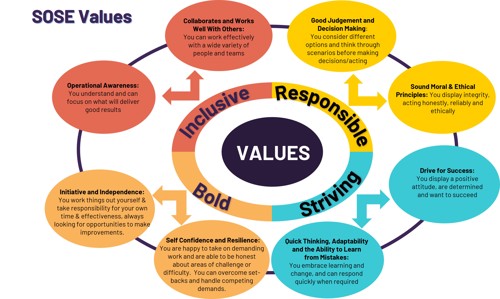Applying to SOSE
Interested in applying to SOSE? Here’s some advice to help your job application succeed.
How to write a compelling job application
It’s important to spend time on your application form, to give yourself the best chance of success. We use forms because they’re considered best practice, by allowing a more transparent and objective process. Our software anonymises your application, to minimise bias from identifying factors, such as name, age and location.
Imagine the people who will be reading your application, and remember that clarity, answering the questions, and evidence of relevant experience go a long way.
Key tips:
Step 1
Do your research
Read up about SOSE and the role you’re applying for. Make sure you understand the essential job requirements. Learn about the job context and SOSE’s priorities.
The Regional Economic Strategy and Operating Plan are good places to get a better feel for SOSE as a whole. The application form is very important, but if you don’t read the background material, you may seem uninformed about SOSE and the mission you’ll be part of.
As well as understanding the core job competencies, make sure you’re familiar with SOSE’s key values (see below). These explain the behaviours and culture SOSE encourages in staff.
Step 2
Plan your application
Your application needs to be closely tailored and mapped to the job description. You need to take each element of the person specification in turn, describe how you fit, and back it up with evidence or relevant achievements.
Always write and edit your application, before copying it into the online form. Go through each element of the person specification, and check you’ve addressed the criteria.
The application form is divided into sections, and each one is there for a reason. Don’t just paste in the same information each time. Answer the question with a clear explanation, and evidence of how you fit the criteria.
Don’t assume the people reading your application have prior knowledge, and be sure your statements can be backed by evidence and examples. Your application is scored section by section against how well it fits the criteria.
Step 3
Personal statement
This is a chance to stand out, bring your application to life, and show personality and passion for the job. It’s also a chance to reinforce key points and provide concrete evidence that you have the skills and qualities we’re looking for.
Summarise why you’re applying for the role, what attracts you to the organisation and how your values align. Show you’ve done your research, use language that shows enthusiasm, and explain how SOSE would benefit from employing you.
Step 4
Check and check again
Make sure your application is clear, logical, reads well, and has no spelling or grammar mistakes. Check that you’ve answered the questions and addressed the job requirements. If possible, get someone else to read your final version – it can sometimes be hard to see the wood for the trees!
Step 5
And finally
Remember this is your personal sales document. Show why you deserve to be shortlisted for interview, by making it clear, relevant, evidence and achievement-focused, and interesting for the reader. This will give you a far better chance of securing an interview.
What to expect at interview
Our interviews may be conducted in person, at one of our office locations, or online via MS Teams. The format of each individual interview will be confirmed in the interview invitation email which is issued to candidates. If your interview is via MS Teams you don’t need an account or software for this. We’ll simply send you a calendar invitation with a link, and you can access the interview using your desktop computer, tablet or smart phone.
Before the interview, make sure:
- your device has a working camera and microphone
- you have a good internet connection
- your device is fully charged
- you can access a quiet room where you won’t be disturbed
- you prepare in the same way as you would for a face-to-face interview
Our questions
We want to find out more about you, why you want to work for SOSE, and what about the job appeals to you. We’ll also ask questions designed
to find out how you operate in a work environment. To do this, we’ll ask you to talk through examples from your experience. The STAR technique below
is a recognised approach we use for this. Prepare by spending some time taking notes on successes, experiences and situations you’ve been in,
and which you feel comfortable talking through. These could be experiences from work, school or university, voluntary work, or your personal life.
Think about the skills, knowledge and personal attributes needed in the job description, and what examples you could provide to demonstrate them.
Try to think of varied examples, as this will help to show breadth of experience. It’s best if your examples are recent, too.
You’re welcome to bring notes to the interview, but bear in mind that we want to have an interactive conversation with you, so try not to rely on them.
We’ll encourage you to take your time to think of the most appropriate example to talk through for each question. We want to ensure that
you can really demonstrate the skills and experience we’re looking for.
Good luck with your interview!
Star technique

Key values

How to Apply FAQs
For answers to practical questions that applicants often ask us, please check out the Frequently Asked Questions.
